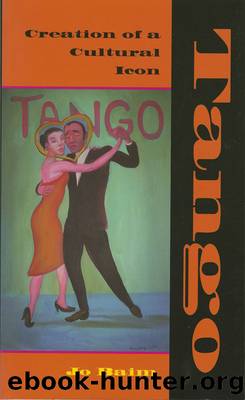Tango by Jo Baim

Author:Jo Baim
Language: eng
Format: epub
ISBN: 9780253027757
Publisher: Indiana University Press
Example 4.1. Examples of tangos compared by Carlos Vega: (a) the earlier Andalusian version and (b) a later version found in Argentina. Carlos Vega, âEl tango andaluz y el tango argentine,â La prensa (Buenos Aires), April 10, 1932.
Apparently this melody was so popular that many different texts were adapted to it. Vegaâs quotations of the Andalusian and later Argentine version are included as Example 4.1., parts a and b, respectively.
In the second half of his article, Vega addresses the confusion surrounding the terms tango, habanera, and milonga as they were used inconsistently for songs, instrumental pieces, and dances. He gives five categories where names were mixed and matched: (1) the habanera called tango, (2) the tango andaluz called habanera, (3) the tango andaluz called milonga, (4) the habanera called milonga, and (5) the milonga called tango. In the first four cases he cites examples of music that appeared at one time with one label and at one time with another, depending on editorâs choices or popular usage. In the fifth example, however, he builds a case for the development of the 1880s song and dance form known as the Argentine tango. Vega says that around 1880 in Buenos Aires, several kinds of popular songs coexisted that used the habanera as a common rhythmic base. One form was the Cuban habanera, which Vega claims appeared around the mid-nineteenth century and had the highest artistic quality and the widest influence. There was also the tango andaluz, discussed earlier, which was less widely known at midcentury. The third type of song was the milonga from the Argentine pampasâthe best-known song type, but at midcentury not yet called milonga.
Vega deals with the common appearance of the basic habanera rhythm by saying that this rhythm was common to all Hispanic American music. He places the earliest appearances of this rhythm in the notations of rabbinical collections in late medieval Spain5 and therefore does not credit the rhythm of the tango to any one modern Hispanic or African source.
Of the three song types Vega describes, the tango andaluz and the habanera had choreographies. The milonga, according to Vega, did not acquire a connection with dance until around 1870, when it joined the others in Buenos Aires. Vega explains how they all joined together to form the Argentine tango:
The milonga⦠acquired choreographic possibilities through its proximity to the habanera, quickly carried out by the compadrito with great originality. In spite of that, the milonga has nothing to do with the habanera, either melodically or choreographically, although when the musicians exhausted the repertoire of milongas at the dances, habaneras served up the same beat to the same effect. The very interesting figure of the compadrito still has not been fully studied. To give the milonga its choreography, they had nothing more suitable to use than their own contortions, slips, and slides, which had distinguished their own style of dancing the mazurka, the polka, or the habanera; and when these disappeared,6 all of the new choreography had to be absorbed by the milonga and then by the Argentine tango.
Download
This site does not store any files on its server. We only index and link to content provided by other sites. Please contact the content providers to delete copyright contents if any and email us, we'll remove relevant links or contents immediately.
The Sweetest Waltz (Music, Dance & Romance series Book 1) by Black De-ann(282)
Ballroom Dancing Christmas Romance: Christmas in Edinburgh (Music, Dance & Romance series Book 3) by Black De-ann(265)
Teaching Dance Studies by Judith Chazin-Bennahum(156)
Tales of a Tiller Girl by Irene Holland(126)
Interdisciplinary Arts by Ostersmith Suzanne(112)
Tango by Jo Baim(104)
Sand Dancer: A Ryan Jarrod Tyneside Crime Mystery by Colin Youngman(102)
Sand Dancer by Colin Youngman(101)
Folk Dance and the Creation of National Identities: Staging the Folk by Anthony Shay(93)
Uday Shankar and His Transcultural Experimentations Dancing Modernity by Urmimala Sarkar Munsi(83)
